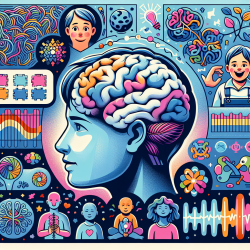Introduction
As practitioners dedicated to improving outcomes for children with Autism Spectrum Disorder (ASD), understanding the neural underpinnings of self-regulation can be a game-changer. Recent research titled "Association of self-regulation with white matter correlates in boys with and without autism spectrum disorder" sheds light on the distinct white matter properties in boys with ASD compared to typically developing controls (TDC). This blog explores how these findings can inform and enhance therapeutic practices.
Key Findings from the Research
The study utilized diffusion spectrum imaging (DSI) to analyze white matter (WM) tracts in 59 boys with ASD and 62 TDC boys. The researchers discovered a single mode of brain-behavior co-variation linking diagnosis, dysregulation, and intelligence to specific WM property patterns. Key findings include:
- Higher generalized fractional anisotropy (GFA) in certain tracts was associated with less dysregulation in ASD but more dysregulation in TDC.
- No shared WM correlates of dysregulation were identified between ASD and TDC, highlighting distinct neural mechanisms.
Implications for Practice
Understanding these neural differences can help practitioners tailor interventions to better support self-regulation in children with ASD. Here are some practical steps to consider:
- Personalized Interventions: Use insights from WM tract differences to develop personalized therapy plans that address specific self-regulation challenges.
- Focus on Emotional Regulation: Given the link between WM tracts and emotion regulation, incorporating strategies that enhance emotional understanding and control can be beneficial.
- Collaborate with Neuroscientists: Engage with researchers to stay updated on the latest findings and integrate cutting-edge science into practice.
Encouraging Further Research
While this study provides valuable insights, it also opens the door for further exploration. Practitioners are encouraged to engage in or support research that delves deeper into the neural correlates of self-regulation in ASD. Understanding the complexities of WM properties can lead to more effective interventions and better outcomes for children.
Conclusion
The distinct white matter correlates identified in boys with ASD underscore the importance of a nuanced approach to therapy. By leveraging these insights, practitioners can enhance their strategies, leading to improved self-regulation and overall outcomes for children with ASD. For a more detailed understanding, practitioners are encouraged to read the original research paper: Association of self-regulation with white matter correlates in boys with and without autism spectrum disorder.










